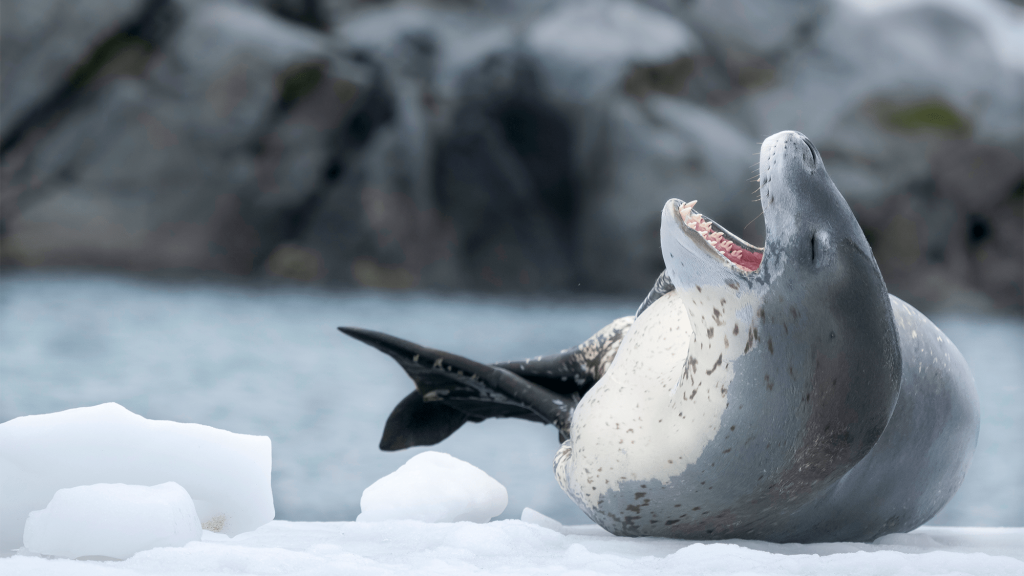Earth’s oceans have always been a wild world of sound. A symphony of chatter between creatures, rain hitting the surface, the boom of calving ice, the thunders of waves and fizz of bubbles, the rumble of undersea earthquakes, and even mysterious quacking sounds.
Still, time has moved slowly and surely on our restless Earth. Across its roughly 4-billion-year history, the ocean’s soundscape has evolved gradually, in a rhythmic tandem with the transformation of the planet itself. But in just the last two centuries, it has shifted dramatically, growing ever louder and more chaotic, due to a cacophony of human-made noise. Activities such as global shipping, seismic airgun surveys for oil and gas, offshore construction and drilling, and the emerging threat of deep-sea mining now flood the seas with constant, disruptive sound.
This rising din threatens to drown out the ocean’s own voices—songs so well-structured that a leopard seal’s (Hydrurga leptonyx) melody appears to fall somewhere between a dolphin whistle and a human lullaby.
[ Related: As humans get louder, monkeys mark more territory. ]
A brief history of ocean noise
With the dawn of the Industrial Revolution came steamships crisscrossing the oceans, introducing steady low-frequency noise from engines and propellers as global trade expanded. By 1950, shipping traffic increased fivefold, with bigger ships and noisier propellers. Between 1964 and 2004, ambient noise levels in the 30-50 Hz band increased by tenfold in sound energy. And in the years since 2004, the global shipping fleet has seen a cumulative growth of approximately 110%.
Climate change is also rewriting the ocean’s acoustic script. As the seas warm, researchers have found that sound carries farther, and that rising acidity alters the very chemistry of how vibrations move through saltwater, reshaping the pathways of song and echo. Meanwhile, thinning ice sheets form strange acoustic ceilings, trapping sound in shallow layers where it ricochets and lingers. Human-made sounds ripple through the warming seas, drowning out the delicate echolocations and calls of marine life, leaving once-clear signals lost in a growing oceanic roar. The average cargo ship produces a steady rumble between about 20 and 200 hertz, roughly the same low-frequency band as a bass speaker, at a volume that’s on par with a chainsaw at close range.
And, we’re only beginning to understand its impacts on marine species. The songs at risk
The songs at risk
Since water is a denser, more resistant element than air, it bends and muffles light and sound in ways that terrestrial life never quite encounters. Below 328 feet, nearly all sunlight has vanished, so ocean life has learned to “see” in other ways over time. Over millennia, marine animals have honed ears and sonar-like abilities to read their world in vibrations and echoes, turning the ocean into a place both alive with sound and fine-tuned to its subtleties.
Such noise is particularly critical for cetacean communication, where it is used for navigation, hunting, mating, and social bonding. Humans have long studied echolocation, noting how dolphins and some whales emit clicks and listen to the returning echoes to map their world.And yet, this same reliance on sound that makes their communication so spectacular, leaves them especially vulnerable to anthropogenic noise intruding into their environment.
Dolphins can have disrupted hunting and social behaviors from loud noise, while whales may abandon critical habitats or change migration routes in response. Narwhals have exhibited intense fear responses to seismic airguns used in oil and gas exploration, making sudden, deep dives to escape the blasts. Some whales have become stranded or collided with ships when overwhelmed by anthropogenic noise, while others have been left to, dangerously, reduce singing altogether.
For many species, scientists are only beginning to recognize the role of sound in their survival, including leopard seals. A study recently published in Scientific Reports found that leopard seals arrange their songs with a surprising sense of order.
Each breeding season, male leopard seals dive beneath the ice and repeat long, solitary sequences of five distinct call types for hours on end. Researchers analyzed those patterns using a tool from information theory called entropy, which quantifies how much variation or randomness is within a patterned sequence. They discovered the seals’ underwater arias were more structured than dolphin whistles or humpback songs, yet less rigid than human music. In fact, the seals landed in the same statistical range as nursery rhymes, where repetition and predictability help a message carry and be remembered.

CREDIT: University of New South Wales/Aleksander Wynne,/Tracey Rogers
“We can’t assume that a particular sound has a particular meaning in the way that we do with words,” Lucinda Chambers, a marine bio acoustician at the University of New South Wales in Australia and the study’s lead author, tells Popular Science. “But we can assume that a particular combination of sounds is very meaningful.”
These sound combos placed leopard seals curiously alongside us. When their calls were compared against everything from squirrel monkey chatter to melodies by the Beatles, their songs showed a balance of randomness and order that suggests style, not just repertoire, matters for communication. In the vast and noisy Southern Ocean, such predictability may be the key to helping rivals or potential mates recognize an individual voice across miles of ice and water.
Each male combines the five call types in his own fixed sequence—functioning almost like a personal name that allows others to recognize him across the ice, notes Chambers.
[ Related: Arctic seals have special noses. ]
Few safe havens
The original leopard seal recordings were captured in remote, rugged Antarctica during the 1990s. Yet even here, at the bottom of the Earth, the soundscape is shifting. The continent remains relatively insulated from the constant hum of shipping lanes or coastal industry, yet it is not immune. Tourism, krill fishing, and vessel traffic are all on the rise.
“It’s getting louder and louder,” says Chambers, who notes that scientists are only beginning to understand how such changes in background noise might alter the way leopard seals and other marine animals learn and pass down their songs.
Leopard seals are intensely solitary mammals, scattered across vast stretches of pack ice, which makes it unclear how young seals ever learn the breeding songs in the first place. Females do sing, though not with the same long, patterned displays as males. Researchers suspect they may play a role in teaching pups,but it remains uncertain.
Many scientists and policymakers across the board are testing solutions to keep the ocean’s acoustic world intact. Quieter ship technologies, speed restrictions in sensitive areas, and designated “quiet zones” can give marine species the breathing room they need. Stricter oversight of industrial activity, adoption of alternative low-noise technologies, and public education campaigns aim to reduce human-generated noise before it overwhelms ocean life.

But even as new tools and strategies emerge to quiet the seas, the legal foundation that has long safeguarded marine life is under pressure.
Since 1972, The Marine Mammal Protection Act has served as a buffer against this cacophony, giving regulators tools to limit harm and protect species from deadly entanglements, vessel strikes, and industrial noise. A proposed reauthorization, however, could weaken those safeguards, lowering the standard from maintaining healthy populations to simply surviving, and limiting the rules agencies can set to reduce human-caused disturbance.
Scientists warn that without strong protections, critical sound-based behaviors (communication, hunting, mating, etc.) could be increasingly disrupted, putting populations at risk.
“Animals will generally increase the loudness of their sounds in response to increasing background noise,” says Chambers. “If their distribution gets interrupted, it will further impact the way these sounds are learnt, or the way these songs are able to be transmitted.”


